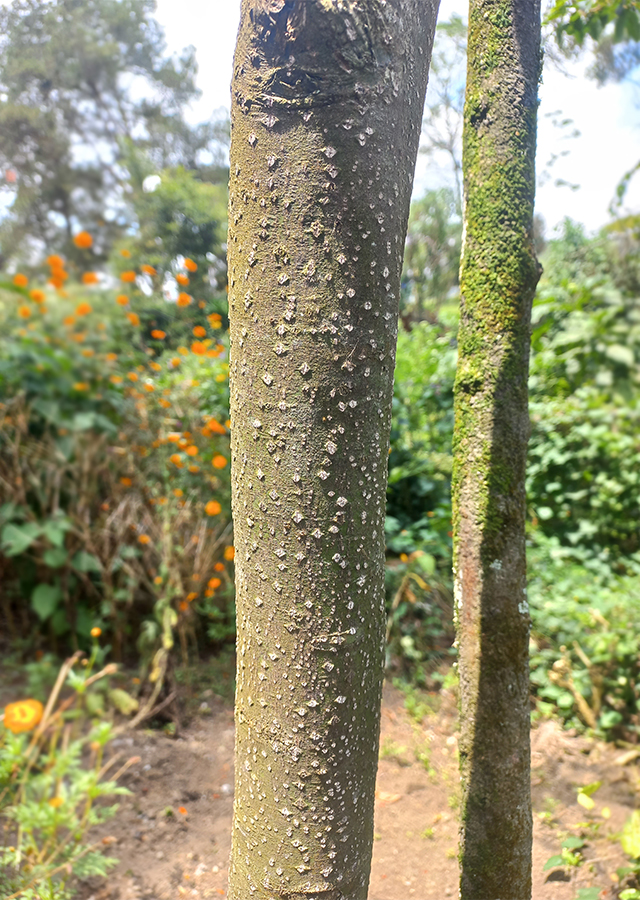Pheasant Pepper Tree
Litsea cubeba (Lour.) Pers.
Lauraceae
Location in our garden
Principal



Synonym
Benzoin cubeba (Lour.) Hatus.
Cubeba pipereta Raf.
Persea cubeba (Lour.) Spreng.
Habitus
Trees. A deciduous to evergreen shrub or small tree growing from 4 - 15 m tall
Part Used
Leaves
Bark
Fruit
Growing Requirements
Full Sunshine
Habitat
Riverbanks
Forest
Mountains
Roadside
Overview
Litsea cubeba is a plant from the Lauraceae family that grows widely in Southeast Asia, eastern Asia (Indochina), and is cultivated on a small scale in Formosa and Japan, southern China, especially the provinces of Guangxi, Zhejinang, and Sichuan. This plant is also found in the mountains of Taiwan, Thailand, northeastern India, and grows wild in Korea, Vietnam, and Indonesia. In Indonesia, it grows in groups on mountain slopes in Sumatra, Kalimantan, and throughout Java. This species has various benefits, including being used in traditional medicine, as a source of food seasoning, a source of essential oils, a source of wood, a pioneer species when restoring native forests, shade trees, windbreaks in plantations. L. cubeba is widely cultivated for its essential oils and has been traded internationally, and is included in the top 10 world trade in essential oils. This essential oil can be produced from all parts of the plant and has very wide uses, namely as an ingredient in medicines, aromatherapy or fragrances, food preservatives, natural pesticides, and various other pharmaceutical products. This oil can also be used directly in the food, cosmetic and cigarette industries. Based on its function as a medicinal plant, in traditional Chinese medicine, L. cubeba has been used for more than hundreds of years as a warming and pain reliever, and is believed to be able to overcome other health problems.
Vernacular Names
Medang ayer (Malay), May chang (Chinese), Chakhai-ton (Thai), Cây màng tang (Vietnamese).
Agroecology
Habitat L. cubeba is generally found in hilly areas, sunny slopes, shrubs, sparse forests, roadsides, river banks and grows well at an altitude of 700-2300 m. In East Kalimantan, L. cubeba was found growing at an altitude of 400-600 m. In Java, this species is found growing in fertile soils and also near sulfur lakes.
Morphology
- Trunks - terete, up to 6(-20) cm in diameter; bark 1 mm thick, very tough, green outside, yellow inside, smooth, with large lenticels, lemon-like scent and pungent taste; branchlets slender, glabrous but apical parts ferrugineous-villose.
- Leaves - alternate, simple, aromatic; petiole 8-18 mm long; blade lanceolate to oblong, 7-15 cm × 1.5-3 cm, base acute, apex long-acuminate, membranaceous or chartaceous, finely pellucid-dotted, brownish-green when young, shiny dark-green above, glaucous below, lateral veins slender, in 8-12 pairs.
- Flowers - Inflorescence an axillary, 4-5-flowered, umbelliform raceme, about 1 cm long; primary peduncle accrescent, up to 1 cm long; secondary peduncle thin, 5-8 mm long, with basal, lanceolate bract and apically a globose involucre of 4 decussate bracts surrounding the umbel like a flower bud. Pedicel minutely puberulous, 3-4 mm long; flower 3-4 mm in diameter, yellowish-white; tepals 5-6, broadly ovate, 1.5-2.5 mm long, outside glabrous; male flowers with 9 stamens in 3 whorls, filaments sparsely hairy, those of 3rd whorl with 2 basal subsessile glands, anthers quadrangular; female flowers with 9 staminodes, a large, glabrous ovary with very short style and a large, multi-lobed stigma.
- Fruits - a globose berry, 5-6 mm across, apiculate when young, blackish when mature, seated on a pedicel 3-5 mm long which is slightly thickened at the apex into a cup-shaped receptacle.
- Seeds - spherical, white.
Cultivation
- Propagated by seeds, stem cuttings and shoot cuttings.
- Seeds that have been sown or sown will germinate in 6-8 weeks and continue for up to 5 months. Seedlings are ready for planting at the age of 9-20 months.
- Plants produced from cuttings can begin to bear fruit when they are only 2 - 3 years old.
Chemical Constituents
Alkaloids (laurotetanine, O-methyloblongine, oblongine, xanthoplanine, magnocararineu), essential oils (citral, limonene, methyl-heptenone, α-pinene, β-pinene, linalool, 1,8-cineole, citronellal, citronellol, sabinene, α-thujene, champene, 2,6-dimethyl-hepten5-al, -terpinene, isolemonine, terpinolene, neo-isopulegol, isopulegol, 4-terpineol, terpineol, trans-carveol, geraniol, geranial, -terpenyl acetate, -copaene, metal cinnamate , metal eugenol, nerol, zingeberene, (E)-karyophyllene, -fernesene, -humulen, -kurkumen, zingiberen, Δ-kadinen, karyophyllene oxide), lauric acid, capric acid, monoterpenoic acid (litseakufree acid) and monoterpenlactone (6R) -3,7-dimethyl-7hydroxy-2-octen-olide, vanillic acid, tran-3,4,5-trimethoxylcinamyl alcohol and oxonantenine, cis-4-desenoic acid, cis-4-dodesenoic acid, and sis-4- tetradesenoate.
Traditional Medicinal Uses
- The roots, branchlets, leaves, and fruits are all used in traditional medicine for treating internal health problems, such as swelling and pain.
- Recent studies have found that the essential oil may be useful in the treatment of cardiac arrhythmia.
- The essential oil has demonstrated antifungal properties against several pathogens including Alternaria alternata; Aspergillus niger; Candida albicans; Fusarium spp; Helminthosporium spp.
- All plant parts of Litsea cubeba are applied medicinally and have antiparalytic, anticephalalgic, antihysteric, carminative, spasmolytic and diuretic properties.
- The fruit is used in decoction for the treatment of vertigo, paralysis and in post-partum preparations.
- Traditionally the Dayak Kenyah people of East Kalimantan use the fruits and bark as oral and topical medicine for babies as well as for adults. It is applied in cases of fever, stomach-ache, chest pain and as a tonic. It is also an antidote to treat drunkenness.
- The leaves are used for treating skin diseases.
- In aromatherapy, the oil is applied as a cooling agent against acne and dermatitis, and to relieve anxiety and stress.
Part Used
Reference Sources
- Royal Botanic Gardens. Plants of the World Online: Litsea cubeba (Lour.) Pers.. https://powo.science.kew.org/taxon/urn:lsid:ipni.org:names:465621-1. 17-09-22.
- Temperate Plants Database, Ken Fern. 2016. Litsea cubeba. https://temperate.theferns.info/plant/Litsea+cubeba. 17-09-22.
- Plant Resources of South-East Asia. 2021. Litsea cubeba (PROSEA). https://uses.plantnet-project.org/en/Litsea_cubeba_(PROSEA). 17-09-22.


